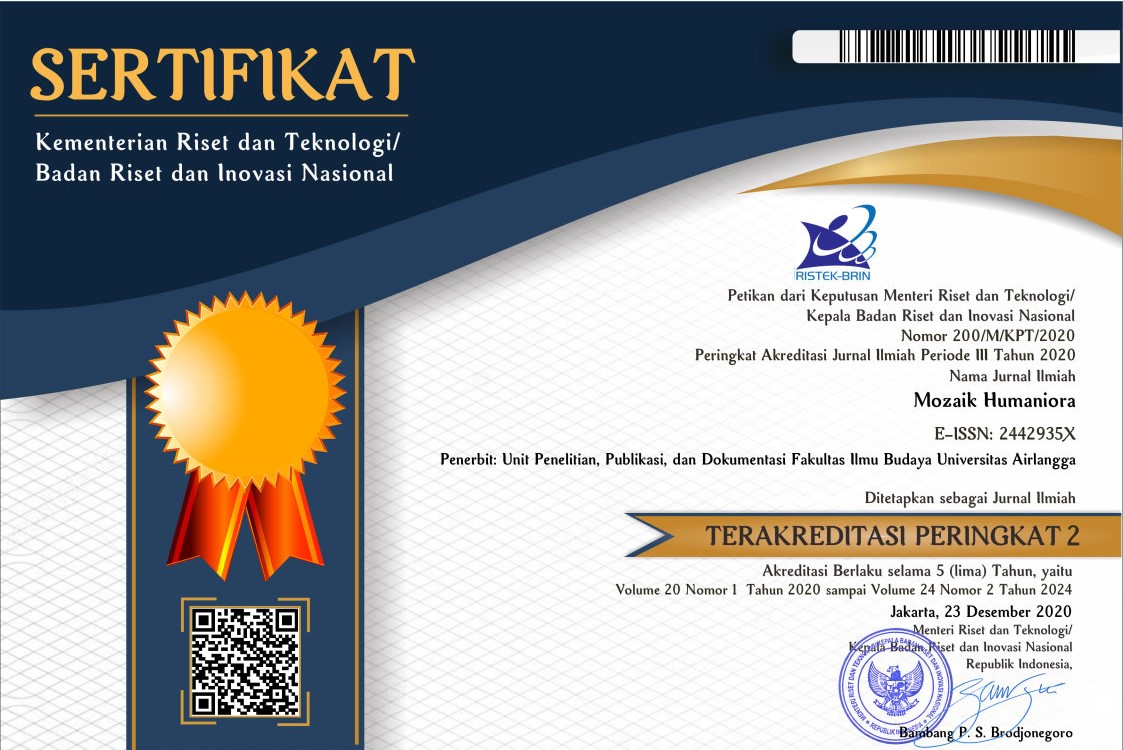The Changes of Settlement Types in the Kajang Area: from Segmentary Society to Chiefdoms
Downloads
This study aims to reveal the current type of community in Kajang area based on social structure, politics, economy, technology, as well as ideology. Kajang area is a traditional region located on the hill sides of Bone Bay Sea shore in the District of Kajang, Bulukumba, South Sulawesi Province. To pursue the aim of this study, descriptive qualitative method is used. The results show that historically, in order to overcome the limitations of facilities and infra structure, communities in Kajang reached other regions either by land or water. Thus, there are various artifacts from megalithic and Islamic cultures indicating the existence of local cultural syncretism with the culture from other regions. All of the artifacts found in Kajang area are bound in a functional fabric, which is limited by the level of supporting human activities, namely community protection activities, religious and ceremonial activities, as well as
household activities. Besides, relics found also indicate that there was a cultural shift in Kajang region, from agrarian culture to maritime one. Thus, the current type of community in Kajang area can be considered to be shifted from segmentary society to chiefdom. Nevertheless, this does not mean that with the emergence of chiefdoms, the segmentary society has simply disappeared.
Adhan, S. 2005. "Islam dan Patuntung di Tanah Toa Kajang: Pergulatan Tiada Akhir.” Dalam Hak-Hak Minoritas: Dilema Multikulturalisme di Indonesia, disunting oleh Hikmat Budiman. Jakarta: Yayasan Interseksi bekerjasama dengan Tifa Foundation.
Ahimsa-Putra, Heddy Shri. 1995. "Arkeologi Pemukiman, Titik Strategis, dan Beberapa Paradigma.” Berkala Arkeologi 15 (3): 10”23. DOI: https://doi.org/10.30883/jba.v15i3.665.
Akib, Yusuf. 2008. Ammatoa Komunitas Berbaju Hitam. Makassar: Pustaka Refleksi.
Binford, Lewis R. 1972. An Archaeological Prespective. New York: Seminar Press.
Clarke, David L. 1977. Spatial Information in Archaelogy, in Spatial Archaeology. London: Academic Press.
Deetz, James. 1975. "Archaeology as Social Science.” Dalam Contemporary Archaeology, disunting oleh M. P. Leone. Carbondale: Southern Illinois University Press.
Dharmaputra, Nick G. 1995. "Kebudayaan Hidup dan Arkeologi.” Kumpulan Makalah Seminar Nasional Metodologi Riset Arkeologi. Depok.
Katu, Mas Alim. 2008. Kearifan Manusia Kajang. Makassar: Pustaka Refleksi.
Mattulada. 1984. "Kebudayaan Bugis Makassar.” Dalam Manusia dan Kebudayaan di Indonesia, disunting oleh Koentjaraningrat. Djambatan : Jakarta.
Moleong, L. J., 1989. Metodologi Penelitian Kualitatif. Bandung: Remaja Jaya.
Palengkahu, dkk. 1970. "Dialek Konjo di Sulawesi Selatan.” Laporan Penelitian. Ujung Pandang: Lembaga Bahasa Nasional Tjabang III.
Renfrew, Colin dan Paul Bahn. 1996. Archaeology, Theories, Method and Practice. Chicago: R. R. Donnelley and Sons Company.
Rouse, Irving. 1972. "Settlement Patterns in Archaeology.” Dalam Man, Settlement and Urbanism, disunting oleh P. J. Ucko, Ruth Tringham, dan G. W. Dimbleby. London: Duckworth.
Tika, Zainuddin, dkk. 2013. Ammatoa. Makassar: Lembaga Kajian dan Penulisan Sejarah Budaya Sulawesi Selatan.
Usop, K. M. A. M. 1985. "Pasang Ri Kajang Kajian Sistem Nilai Masyarakat Amma Toa.” Dalam Agama dan Realitas Sosial, disunting oleh Mukhlis dan Kathryn Robinson. Ujung Pandang: Lembaga Penelitian Unhas (LEPHAS).
Copyright (c) 2022 Erni Erawati

This work is licensed under a Creative Commons Attribution-ShareAlike 4.0 International License.

Mozaik Humaniora is licensed under a Creative Commons Attribution-ShareAlike 4.0 International License. Both authors and Mozaik Humaniora agree with the following attribution of journal:
1. Copyright of this journal is possession of Author, by the knowledge of the Editorial Board and Journal Manager, while the moral right of the publication belongs to the author.
2. The journal allows the author(s) to retain publishing rights without restrictions
3. The legal formal aspect of journal publication accessibility refers to Creative Commons Attribution Share-Alike (CC BY-SA).
4. The Creative Commons Attribution Share-Alike (CC BY-SA) license allows re-distribution and re-use of a licensed work on the conditions that the creator is appropriately credited and that any derivative work is made available under "the same, similar or a compatible license”. Other than the conditions mentioned above, the editorial board is not responsible for copyright violation.


















